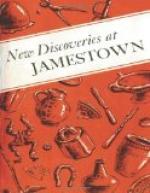[Illustration: Brass casting counters excavated on Jamestown island. Many were made in Germany before 1575 for use by merchants on counting boards. In the new World they were used for the Indian trade.]
[Illustration: A few objects unearthed at Jamestown which were used for trading with the Indians. Shown are glass beads, scissors, iron knives, A Hatchet, and Bell fragments.]
Hatchets.—Many fine specimens of handwrought hatchets have been found. These were valuable items during the early years of the settlement, and much sought after by the Indians, so that a large number were used in trading with them. But hatchets were used primarily by the carpenter, cooper, and other artisans.
Pots and Pans.—A pot or pan made of brass or copper was almost worth its weight in gold for trading purposes. A few complete examples, together with numerous fragments, have been recovered.
Brass Casting Counters or Jettons.—Most of these thin brass tokens or counters (similar in appearance to coins) were made in Germany during the second half of the 16th century. In Europe they were used on counting boards for making mathematical calculations, but in the New World it is believed that they were used in the Indian trade. Approximately a dozen have been found at Jamestown. Three were also found on Roanoke Island (site of Raleigh’s ill-fated “Lost Colony”) and one was recovered in an Indian shell mound near Cape Hatteras, not too distant from Croatoan Island (known today as Ocracoke Island). Many of the counters in the Jamestown collection were made by Hans Schultes and Hans Laufer of Nuremberg, who manufactured such jettons between 1550 and 1574, at which time Nuremberg was a center for the making of casting counters. Some of the counters have holes punched through them, indicating that the Indians may have worn them around their necks like pendants, suspended from leather thongs.
Miscellaneous Items.—Other objects which the English used in trade with the Indians were colored cloth, glass toys, and whistles; but no examples of these have been recovered during archeological explorations.
[Illustration: A wharf scene—arrival of A ship from the mother country. (Conjectural sketch by Sidney E. King.)]
ENGLISH AND FOREIGN TRADE
During the 17th century, active trade was carried on between the Virginia colony and the mother country. Local commodities of timber, wood products, soap ashes, iron ore, tobacco, pitch, tar, furs, minerals, salt, sassafras, and other New World raw materials were shipped to England. In exchange, English merchants sold to the colonists, tools, farm implements, seeds, stock and poultry, furniture and household accessories, clothing, weapons, hardware, kitchen utensils, pottery, metalware, glassware, and certain foods and drinks.




